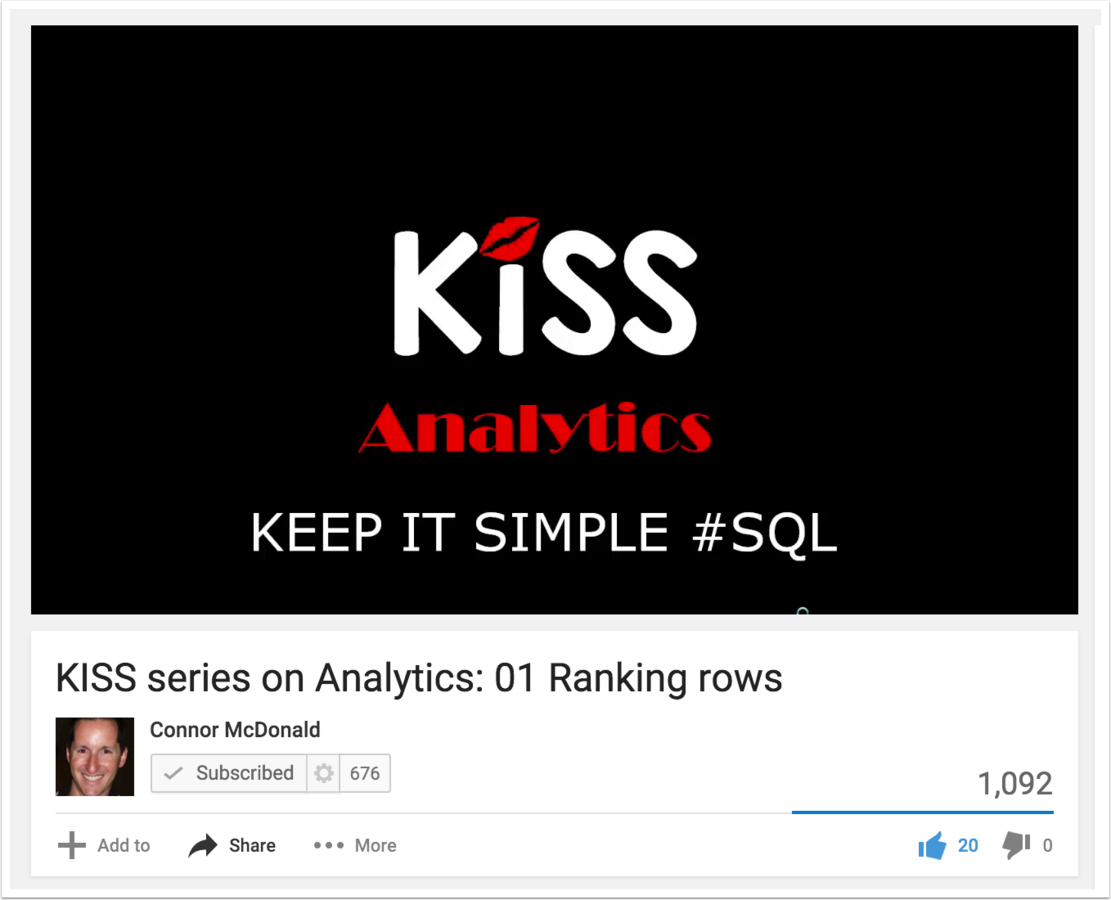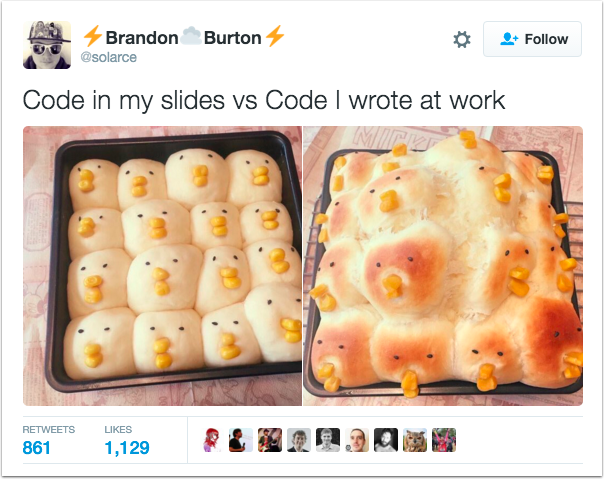Hooked on Classic (Reports)
Learn tips & techniques to make them sing
Jorge Rimblas

Jorge Rimblas
Senior APEX Consultant

- Oracle Database since 1995
- APEX since it was HTMLDB in 2004
- Kscope16 APEX Track Content Lead
- jrimblas in OTN Forums

- Co-author of
"Expert Oracle Application Express, 2nd Edition"
with "Themes & Templates" chapter





- North America’s largest APEX consulting firm
- 12 years working with Oracle APEX
- 80 employees and growing
- Committed to APEX innovation
- Our services: application development, coaching, consulting, EBS extensions, and Forms migration
- Learn more at insum.ca
Agenda
- Why?
- Template Types
- Generic Column Templates
- Named Column Templates
- Analytic Functions
- Limitations
- Resources
The "Manual" Approach
htp.p('<ul>');
for t in (
select id
, todo
, decode(completed_by
, null, ''
, 'check' || '-') checked
from app_todos
)
loop
htp.p('<li>'
|| t.todo
|| ' <i class="fa fa-'
|| t.checked || 'square-o">'
|| '</i>'
|| '</li>');
end loop;
htp.p('</ul>');
Why?
Standard Functionality
Ease of use
Flexibility
No PL/SQL loops



Classic Report examples

Template Types
Generic Columns
&
Named Columns
Generic Columns
Named Columns
Column Template
Row Template

Generic Columns
Every column looks the same
<td>
#COLUMN_VALUE#
</td>Every column looks the same
<td class="t-Report-cell" #ALIGNMENT# headers="#COLUMN_HEADER_NAME#">
#COLUMN_VALUE#
</td>
Column Template Conditions
- Four Column Templates
- Condition for each template
- Condition types: PL/SQL Expression, even or odd rows

Using conditions



Duplicate the template

Modify the template

Assign the template
Step by step details

Named Columns
SQL
Named Columns
select PRODUCT_ID
, PRODUCT_NAME
, PRODUCT_DESCRIPTION
, CATEGORY
, PRODUCT_AVAIL
, LIST_PRICE
from PRODUCTS#PRODUCT_ID#
#PRODUCT_NAME#
#PRODUCT_DESCRIPTION#
#CATEGORY#
#PRODUCT_AVAIL#
#LIST_PRICE#
#COLUMN_VALUE#
Generic Columns
SQL
Named Columns
select PRODUCT_ID
, PRODUCT_NAME
, PRODUCT_DESCRIPTION
, CATEGORY
, PRODUCT_AVAIL
, LIST_PRICE
from PRODUCTS#1#
#2#
#3#
#4#
#5#
#6#
Positional Columns
Simple List
Simple List
<ul>
<li>Orange Juice <i class="fa fa-check-square-o"></i></li>
<li>Milk <i class="fa fa-check-square-o"></i></li>
<li>Eggs <i class="fa fa-square-o"></i></li>
<li>Bread <i class="fa fa-square-o"></i></li>
<li>Cornflakes <i class="fa fa-square-o"></i></li>
</ul>
<li>#TODO# <i class="fa fa-#CHECKED#square-o"></i></li>
<ul></ul>Before Rows
After Rows
Simple List Template

Simple List
<li>#TODO# <i class="fa fa-#CHECKED#square-o"></i></li>

select id
, todo
, decode(completed_by
, null, ''
, 'check' || '-') checked
, completed_by
, completed_on
from app_todosDemo

Adding a link to edit

Benefits
- Standard Classic Report Functionality
- Edit Links
- Dynamic Actions
- Dialog Close
- Refresh
Named Columns
Mixing Layouts

Contact List

Two types of rows

<tr>
<td colspan="2">
<a href="#LINK#">&EDIT_BUTTON.</a>
#PARTY_NAME# - #ROLE# <i class="fa"></i>
</td>
</tr><tr>
<td align="right">#TYPE_NAME#</td>
<td>#ENTRY#</td>
</tr>

<tr>
<td colspan="2">
<a href="#LINK#">&EDIT_BUTTON.</a>
#PARTY_NAME# - #ROLE# <i class="fa"></i>
</td>
</tr><tr>
<td align="right">#TYPE_NAME#</td>
<td>#ENTRY#</td>
</tr>
select party_id
, party_name
, role
, type_name
, entry
, active_ind
from parties
<tr>
<td colspan="2">
<a href="#LINK#">&EDIT_BUTTON.</a>
#PARTY_NAME# - #ROLE# <i class="fa"></i>
</td>
</tr><tr>
<td align="right">#TYPE_NAME#</td>
<td>#ENTRY#</td>
</tr>
select party_id
, party_name
, role
, type_name
, entry
, active_ind
from parties
where party_id = 41For a single row
Use both types of rows
For a single row
Or the 1st Party Row
Use both types of rows
Special Case

Analytic Functions
Analytics Syntax
<function> (<arg1>, <arg2>, )
OVER (
< partition clause >
< sorting clause >
< windowing clause >
)row_number()
over (
partition by party_id
order by party_name, entry
)Analytics
select party_id
, party_name
, entry
, row_number() over (
partition by party_id
order by party_name, entry) rn
from parties
PARTY_ID PARTY_NAME ENTRY RN
--------- ------------------ -------------------------------- -------
1 Scott, Michael 800 555-1212 1
1 Scott, Michael 952 555-1212 2
1 Scott, Michael michael.scott@dm.us 3
21 Schrute, Dwight 800 555-1212 1
21 Schrute, Dwight TheSilentNinja@SchruteFarms.com 2
21 Schrute, Dwight dschrute@dm.us 3
21 Schrute, Dwight ceo@SchruteFarms.com 4
41 Halpert, James D. 800 555-1212 1
8 rows selected.count(*) as analytic
select party_id
, party_name
, row_number() over (
partition by party_id
order by party_name, entry) rn
, count(*) over (
partition by party_id
) total_rows
from parties
PARTY_ID PARTY_NAME RN TOTAL_ROWS
--------- ------------------ --- -----------
1 Scott, Michael 1 3
1 Scott, Michael 2 3
1 Scott, Michael 3 3
21 Schrute, Dwight 1 4
21 Schrute, Dwight 2 4
21 Schrute, Dwight 3 4
21 Schrute, Dwight 4 4
41 Halpert, James D. 1 1
8 rows selected.KISS series on Analytics
by Connor McDonald

select party_id
, party_name
, role
, type_name
, entry
, row_number() over (partition by party_id
order by party_name, entry) rn
from parties
:RN = 1Putting it all together
Create a new template




<tr>
<td colspan="2">
<a href="#LINK#">&EDIT_BUTTON.</a>
#PARTY_NAME# - #ROLE# <i class="fa"></i>
</td>
</tr><tr>
<td align="right">#TYPE_NAME#</td>
<td>#ENTRY#</td>
</tr>
<tr>
<td align="right">#TYPE_NAME#</td>
<td>#ENTRY#</td>
</tr>
Column Template 1
Column Template 2
<tr>
<td colspan="2">
<a href="#LINK#">&EDIT_BUTTON.</a>
#PARTY_NAME# - #ROLE# <i class="fa"></i>
</td>
</tr>
<tr>
<td align="right">#TYPE_NAME#</td>
<td>#ENTRY#</td>
</tr>
Column Template 1
Adding some markup
:RN = 1<tr>
<td colspan="2">
<a href="#LINK#">&EDIT_BUTTON.</a>
#PARTY_NAME# - #ROLE# <i class="fa"></i>
</td>
</tr>
<tr>
<td align="right">#TYPE_NAME#</td>
<td>#ENTRY#</td>
</tr>
Column Template 1
<tr class="newContact rowStatus_#ACTIVE_IND#">
<td colspan="2" class="t-Report-cell heading">
<a href="#LINK#" class="contactEdit" data-id="#PARTY_ID#">&EDIT_BUTTON.</a>
<span class="name">#PARTY_NAME#</span> - <span class="roleName">#ROLE#</span>
<i class="fa cfa-check_#ACTIVE_IND# cfa-1_5x" title="#ACTIVE_IND#"></i>
</td>
</tr>
<tr>
<td align="right" class="t-Report-cell contactType">#TYPE_NAME#</td>
<td class="t-Report-cell contactEntry">#ENTRY#</td>
</tr>
Adding some markup

:RN = 1
<tr>
<td align="right">#TYPE_NAME#</td>
<td>#ENTRY#</td>
</tr>
Column Template 2

Contact List
Limitations
- Some HTML knowledge
- Templates are not that re-usable
- New columns require template changes
- Only 4 template conditions
- Potential Pagination Issues
- Limited support for Interactive Reports
Interactive Reports
Detail View

Blogs & References
- Demo App apex.oracle.com/pls/apex/f?p=89361 [ Github]
- Demo Video Series
http://rimblas.com/blog/videos/ - Using Conditions with Column Templates
rimblas.com/blog/2014/05/using-conditions-with-column-templates/ - KISS Analytics playlist
https://www.youtube.com/playlist?list=PLJMaoEWvHwFJDyhMLCkNSSUQWw9waFkIj - APEX Reports: Color Row Based On Column Value
ww.eberapp.com/pls/apex/f?p=BLOG:READ:0::::ARTICLE:5983100346022749 - APEX Reports: Custom Layout with Named Column (Row Template)
ww.eberapp.com/pls/apex/f?p=BLOG:READ:0::::ARTICLE:5976400346831048 - Reinventing APEX Reporting
morneau.me/reinventing-apex-reporting/ - Oracle APEX 5 Classic Report Templates
storm-petrel.com/orablog/2015/12/20/oracle-apex-5-classic-report-templates/
Q&A
Hooked on Classic (Reports)


Jorge Rimblas
apex.world Your one stop for everything APEX
Hooked on Classic Reports
By Jorge Rimblas
Hooked on Classic Reports
Visit http://rimblas.com/blog/2016/06/apex-classic-report-named-column-templates/ for companion videos to this presentation. Hooked on Classic (Reports): learn tips & techniques to make them sing. Using the lowly Classic Report template, this presentation will cover how to take advantage of the Generic Columns and Named Columns template types. We will examine a complex report layout using Named Columns template. We will also look at advanced querying techniques, such as analytic functions, to further customize the report. By inspecting underlying HTML structures, we will gain an understanding of how these templates work. The techniques and functionality covered are standard in APEX and often greatly underutilized. They have been around for several versions of APEX, yet many developers don't know how to use them or that they even exist.
- 4,489






